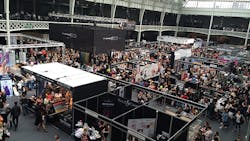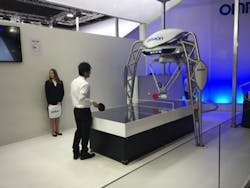How Can Expos Benefit Your Engineering Department?
Expositions/trade shows are a great source of information and exposure, as well as a way to connect with clients. Unfortunately, successful new-customer acquisition can be a gamble at some shows. A clear way to get more attention per dollar is to focus on your engineering, not marketing, department. What if companies viewed expos as an engineering project rather than a marketing venture?
Two years ago, Stratasys, the Stan Winston School of Character Arts, and Legacy Effects built Bodock—a 14-ft. monster—to walk around Comic-Con. It took six weeks and 7,500 collaborative hours to create this marketing phenomenon. It was quite an engineering feat to accomplish so much in such a short time frame.
In 2014, Omron Robotics also invested engineering dollars into its show presence by unveiling a ping-pong playing robot (below). The robot played against a professional table-tennis player, Timo Boll. While the robot didn’t win that game, Omron’s robot is still giving the company ROI, volleying with awestruck visitors at this year’s Hannover Messe.
If engineering is about problem-solving, special projects for expos present a creative way to keep engineers sharp while creating an eye-catching, potentially abstract, marketing visual. In today’s viral marketing world, a failure may go farther than a success. While many might see a failure, an executive or engineer might see someone having similar challenges or someone with whom they can collaborate.
David Allison, the Smithsonian’s Project Director for the American Enterprise exhibition, related the success of the U.S. to a culture in which you won’t lose face or be shamed for trying and not achieving a goal. While it can be embarrassing, you pick yourself up and try again. This mentality has spawned companies from garages and innovation in R&D labs across the U.S.
“It’s a forcing function,” says Lonnie Love, group leader for the manufacturing system research group at Oak Ridge National Laboratory. “Expos force a company to go big and, for 3D printing, make big parts fail early and quickly. By doing so, we are going to accelerate the development of the technology that might otherwise take years. It’s scary because you are sticking your neck out there, but I’d rather try than not try at all.”
Dealing with Deadlines
It also sounds like an interesting way to bring the pressure and excitement of a startup to larger corporations. If you’re a member of a large corporation, missing a deadline might not be catastrophic. This might lead to complacency or slower R&D cycles. In contrast, engineers employed by startups are forced to think of creative solutions because they don’t always have the option to miss a deadline. By publicly setting deadlines for expos, larger companies can therefore drive the creativity and innovative spirit of their engineering departments beyond their normal—and comfortable—limits. Whether they succeed or fail, the resulting marketing inertia will outperform any “neat” looking booth.
Two years ago, for example, Oak Ridge said that it would 3D-print a car with Local Motors, Cincinnati Incorporated, and AMT for the International Manufacturing Technology Show (IMTS). Love says, “We knew theoretically it could be done; we just weren’t sure exactly how.”
It took six days of nearly round-the-clock work, but the 3D-printed car, called Strati, took a victory lap around McCormick Place before the end of the show. By setting a public deadline, engineers were pushed to produce a car that had gone from design to driving in six months. It was printed in less than 50 pieces over the six-day period of the show.
Love’s team now has its sights on the 2017 CONEXPO-CON, where it plans on 3D-printing the boom arm of an excavator. “There is a lot of interest in large 3D-printing of metal parts,” notes Love. “Stepping forward and saying we are presenting this at the show acts as an accelerator.”
In closing, creating major engineering innovations for display and publicity at expos is a win for the companies and organizations behind their development. Ideally, such projects also drive new engineering advances and approaches. “We need to celebrate companies that go over the top with their demonstrations, and encourage this type of innovation,” says Love.
If you have seen a cool demonstration at a show, leave a comment below. With enough comments , I might create a gallery from the findings.


